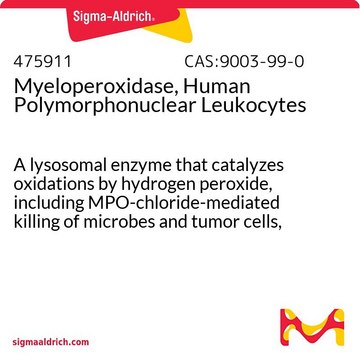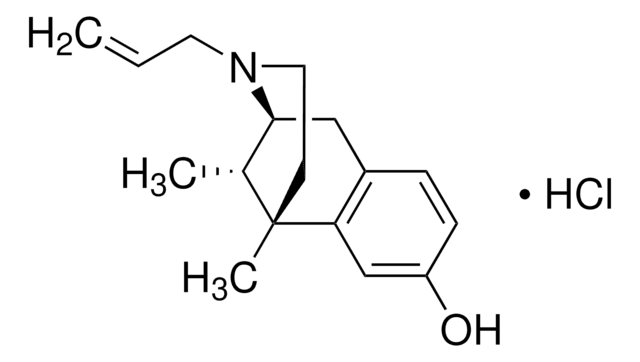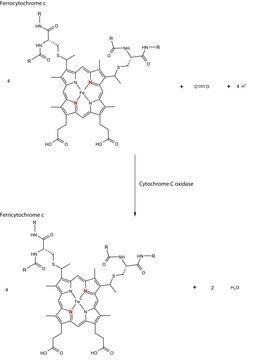A3672
Azurin
from Pseudomonas aeruginosa, lyophilized powder
Iniciar sesiónpara Ver la Fijación de precios por contrato y de la organización
About This Item
Número de CAS:
Número CE:
Número MDL:
Código UNSPSC:
12352202
NACRES:
NA.61
Productos recomendados
origen biológico
Pseudomonas aeruginosa
Nivel de calidad
Formulario
lyophilized powder
composición
Protein, ≥65% Lowry
concentración
≥65.0% (Lowry)
técnicas
toxicology assay: suitable
solubilidad
water: soluble 1—1.1 mg/mL, clear, blue (light blue to blue)
Nº de acceso UniProt
temp. de almacenamiento
−20°C
Información sobre el gen
Pseudomonas aeruginosa ... AZU(878046)
¿Está buscando productos similares? Visita Guía de comparación de productos
Descripción general
Research area: Apoptosis. Azurinis a periplasmic protein and is a homotetramer.
Aplicación
Azurin has been used:
- in the cytotoxicity and cell viability studies in human osteosarcoma cell line
- for the functionalization of silicon nitride cantilevers for interaction studies
- for coating gold surface and insulating functionalized oxide surfaces of silicon oxide and mica
Acciones bioquímicas o fisiológicas
Azurin acts as an electron donor for nitrite reductase in bacterial denitrification process. It exhibits anticancer activity as it hampers various independent signaling pathways associated with cancer progression. It binds to tumor suppressor protein p53 and induces cancer cell apoptosis or stalls cancer cell growth. Azurin disrupts angiogenesis by reducing the activity of VEGFR-2tyrosine kinase thereby inhibiting tumor growth. It has been observed to show cytotoxicity in human breast cancer cells and human melanoma cells.
Azurin is a metalloprotein in the family of cupredoxins. It preferentially enters cancer cells over normal cells and induces apoptosis. Azurin has structural similarities to ephrinB2, and in fact binds the ephrin receptor tyrosine kinase EphB2 to initiate cell signaling that is involved in cancer progression. Azurin inhibits autophosphorlyation of the EphB2 tyrosine residue, interfering with upstream cell signaling and contributing to cancer cell growth inhibition.
Forma física
Lyophilized powder containing ammonium acetate buffer salts.
Código de clase de almacenamiento
11 - Combustible Solids
Clase de riesgo para el agua (WGK)
WGK 3
Punto de inflamabilidad (°F)
Not applicable
Punto de inflamabilidad (°C)
Not applicable
Equipo de protección personal
Eyeshields, Gloves, type N95 (US)
Elija entre una de las versiones más recientes:
¿Ya tiene este producto?
Encuentre la documentación para los productos que ha comprado recientemente en la Biblioteca de documentos.
Yunlei Zhang et al.
Applied and environmental microbiology, 78(21), 7603-7610 (2012-08-28)
Many studies have demonstrated that intravenously administered bacteria can target and proliferate in solid tumors and then quickly be released from other organs. Here, we employed the tumor-targeting property of Escherichia coli Nissle 1917 to inhibit mouse B16 melanoma and
Krzysztof Kazimierczuk et al.
Journal of magnetic resonance (San Diego, Calif. : 1997), 223, 1-10 (2012-09-11)
The resolution of multidimensional NMR spectra can be severely limited when regular sampling based on the Nyquist-Shannon theorem is used. The theorem binds the sampling rate with a bandwidth of a sampled signal and thus implicitly creates a dependence between
Bacterial redox protein azurin induce apoptosis in human osteosarcoma U2OS cells
Yang DS, et al.
Pharmacological Research, 52(5), 413-421 (2005)
Ajay Kumar Yagati et al.
Biosensors & bioelectronics, 40(1), 283-290 (2012-08-14)
We developed a nanoscale memory device consisting of signal-responsive biomaterial, which is capable of switching physical properties (such as electrical/electrochemical, optical, and magnetic) upon application of appropriate electrical signals to perform memory switching. Here, we propose a highly robust surface-confined
Daniel Raimunda et al.
Metallomics : integrated biometal science, 5(2), 144-151 (2013-01-29)
Pseudomonas aeruginosa, an opportunistic pathogen, has two transmembrane Cu(+) transport ATPases, CopA1 and CopA2. Both proteins export cytoplasmic Cu(+) into the periplasm and mutation of either gene leads to attenuation of virulence. CopA1 is required for maintaining cytoplasmic copper levels
Nuestro equipo de científicos tiene experiencia en todas las áreas de investigación: Ciencias de la vida, Ciencia de los materiales, Síntesis química, Cromatografía, Analítica y muchas otras.
Póngase en contacto con el Servicio técnico








